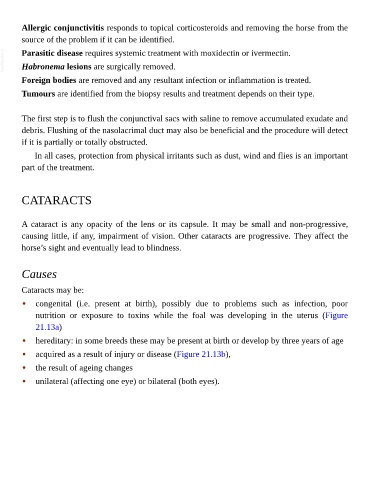Page 990 - The Veterinary Care of the Horse
P. 990
Allergic conjunctivitis responds to topical corticosteroids and removing the horse from the
source of the problem if it can be identified.
VetBooks.ir Parasitic disease requires systemic treatment with moxidectin or ivermectin.
Habronema lesions are surgically removed.
Foreign bodies are removed and any resultant infection or inflammation is treated.
Tumours are identified from the biopsy results and treatment depends on their type.
The first step is to flush the conjunctival sacs with saline to remove accumulated exudate and
debris. Flushing of the nasolacrimal duct may also be beneficial and the procedure will detect
if it is partially or totally obstructed.
In all cases, protection from physical irritants such as dust, wind and flies is an important
part of the treatment.
CATARACTS
A cataract is any opacity of the lens or its capsule. It may be small and non-progressive,
causing little, if any, impairment of vision. Other cataracts are progressive. They affect the
horse’s sight and eventually lead to blindness.
Causes
Cataracts may be:
• congenital (i.e. present at birth), possibly due to problems such as infection, poor
nutrition or exposure to toxins while the foal was developing in the uterus (Figure
21.13a)
• hereditary: in some breeds these may be present at birth or develop by three years of age
• acquired as a result of injury or disease (Figure 21.13b),
• the result of ageing changes
• unilateral (affecting one eye) or bilateral (both eyes).

